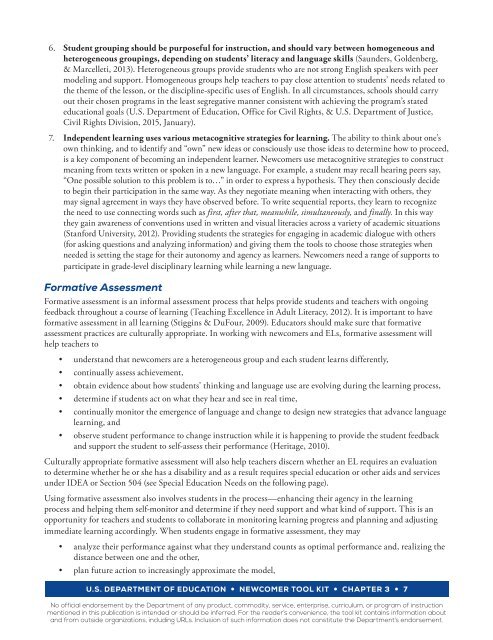NEWCOMER TOOL KIT
xYhe4
xYhe4
Create successful ePaper yourself
Turn your PDF publications into a flip-book with our unique Google optimized e-Paper software.
6. Student grouping should be purposeful for instruction, and should vary between homogeneous and<br />
heterogeneous groupings, depending on students’ literacy and language skills (Saunders, Goldenberg,<br />
& Marcelleti, 2013). Heterogeneous groups provide students who are not strong English speakers with peer<br />
modeling and support. Homogeneous groups help teachers to pay close attention to students’ needs related to<br />
the theme of the lesson, or the discipline-specific uses of English. In all circumstances, schools should carry<br />
out their chosen programs in the least segregative manner consistent with achieving the program’s stated<br />
educational goals (U.S. Department of Education, Office for Civil Rights, & U.S. Department of Justice,<br />
Civil Rights Division, 2015, January).<br />
7. Independent learning uses various metacognitive strategies for learning. The ability to think about one’s<br />
own thinking, and to identify and “own” new ideas or consciously use those ideas to determine how to proceed,<br />
is a key component of becoming an independent learner. Newcomers use metacognitive strategies to construct<br />
meaning from texts written or spoken in a new language. For example, a student may recall hearing peers say,<br />
“One possible solution to this problem is to…” in order to express a hypothesis. They then consciously decide<br />
to begin their participation in the same way. As they negotiate meaning when interacting with others, they<br />
may signal agreement in ways they have observed before. To write sequential reports, they learn to recognize<br />
the need to use connecting words such as first, after that, meanwhile, simultaneously, and finally. In this way<br />
they gain awareness of conventions used in written and visual literacies across a variety of academic situations<br />
(Stanford University, 2012). Providing students the strategies for engaging in academic dialogue with others<br />
(for asking questions and analyzing information) and giving them the tools to choose those strategies when<br />
needed is setting the stage for their autonomy and agency as learners. Newcomers need a range of supports to<br />
participate in grade-level disciplinary learning while learning a new language.<br />
Formative Assessment<br />
Formative assessment is an informal assessment process that helps provide students and teachers with ongoing<br />
feedback throughout a course of learning (Teaching Excellence in Adult Literacy, 2012). It is important to have<br />
formative assessment in all learning (Stiggins & DuFour, 2009). Educators should make sure that formative<br />
assessment practices are culturally appropriate. In working with newcomers and ELs, formative assessment will<br />
help teachers to<br />
• understand that newcomers are a heterogeneous group and each student learns differently,<br />
• continually assess achievement,<br />
• obtain evidence about how students’ thinking and language use are evolving during the learning process,<br />
• determine if students act on what they hear and see in real time,<br />
• continually monitor the emergence of language and change to design new strategies that advance language<br />
learning, and<br />
• observe student performance to change instruction while it is happening to provide the student feedback<br />
and support the student to self-assess their performance (Heritage, 2010).<br />
Culturally appropriate formative assessment will also help teachers discern whether an EL requires an evaluation<br />
to determine whether he or she has a disability and as a result requires special education or other aids and services<br />
under IDEA or Section 504 (see Special Education Needs on the following page).<br />
Using formative assessment also involves students in the process—enhancing their agency in the learning<br />
process and helping them self-monitor and determine if they need support and what kind of support. This is an<br />
opportunity for teachers and students to collaborate in monitoring learning progress and planning and adjusting<br />
immediate learning accordingly. When students engage in formative assessment, they may<br />
• analyze their performance against what they understand counts as optimal performance and, realizing the<br />
distance between one and the other,<br />
• plan future action to increasingly approximate the model,<br />
U.S. DEPARTMENT OF EDUCATION • <strong>NEWCOMER</strong> <strong>TOOL</strong> <strong>KIT</strong> • CHAPTER 3 • 7<br />
No official endorsement by the Department of any product, commodity, service, enterprise, curriculum, or program of instruction<br />
mentioned in this publication is intended or should be inferred. For the reader’s convenience, the tool kit contains information about<br />
and from outside organizations, including URLs. Inclusion of such information does not constitute the Department’s endorsement.


